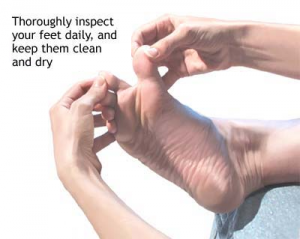This article is about “think feet with diabetes”. About 2 million Canadians are currently living with diabetes. It can be a “silent” disease, as patients may have few symptoms. Once diagnosed with diabetes it is of great importance to be vigilant of lifestyle and nutrition to keep the condition under control. A common problem for about 15% of diabetics is the development of a diabetic foot ulcer. Of those afflicted 14-24% will require an amputation of a lower extremity as a result. In addition to this the mortality rate of patients with below knee amputation due to the complications of a diabetic foot ulcer is 19-55% after three years.
Even though these statistics sound ominous, patients can do a lot in the way of prevention. According to the Canadian Diabetes Association guidelines, a diabetic patient should have a foot exam performed at least annually. Diabetic peripheral neuropathy is the leading cause of diabetic foot ulcers. The physician can examine the feet for loss of sensation. He will check for foot calluses and will debride those, which are pre-ulcer state. The physician also checks for poor circulation in the foot at that time.
If there is no loss of protective sensation, an annual exam will suffice, but if there is loss of sensation, several exams per year may be needed. A vascular surgeon may have to assess the patient to see if the foot circulation is sufficient. Infection is a warning sign and has to be treated promptly. Finally, any source of pressure to the foot needs to be removed or offloaded.
A proactive approach to keep the feet healthy starts at home.
The following points are important especially to the patient with diabetes:
-Inspect your feet on a daily basis. Check for sores, blisters or cracks that don’t heal.
-Check your footwear. If there is debris (sand, pebbles) remove promptly.
-Wash your feet daily with warm, not hot water and dry them well, especially between your toes.
-Trim your toenails. If you have difficulties doing that, seek out the help of a podiatrist. Also don’t use the homemade approach cutting corns and calluses.
-Keep the circulation to your feet going: put up your feet when you sit. Wiggle your toes, move your ankles, don’t cross your legs for long stretches of time.
-Shop for suitable footwear! Ask the sales clerk to measure both of your feet in order to determine the proper size. Shop in the afternoon, as your feet can swell during the day.
-Don’t break in a tight fitting new shoe! This may injure your feet. A new shoe should be comfortable right away.
-Don’t delay looking after problems. If a cut, sore, bruise or blister does not start to heal after a day, see a physician.
Reference: Parkhurst Exchange, October 2006 Edition, page 26
Last edited November 1, 2014






